Zhengtao Yu
MRO: Enhancing Reasoning in Diffusion Language Models via Multi-Reward Optimization
Oct 24, 2025Abstract:Recent advances in diffusion language models (DLMs) have presented a promising alternative to traditional autoregressive large language models (LLMs). However, DLMs still lag behind LLMs in reasoning performance, especially as the number of denoising steps decreases. Our analysis reveals that this shortcoming arises primarily from the independent generation of masked tokens across denoising steps, which fails to capture the token correlation. In this paper, we define two types of token correlation: intra-sequence correlation and inter-sequence correlation, and demonstrate that enhancing these correlations improves reasoning performance. To this end, we propose a Multi-Reward Optimization (MRO) approach, which encourages DLMs to consider the token correlation during the denoising process. More specifically, our MRO approach leverages test-time scaling, reject sampling, and reinforcement learning to directly optimize the token correlation with multiple elaborate rewards. Additionally, we introduce group step and importance sampling strategies to mitigate reward variance and enhance sampling efficiency. Through extensive experiments, we demonstrate that MRO not only improves reasoning performance but also achieves significant sampling speedups while maintaining high performance on reasoning benchmarks.
Multilingual Generative Retrieval via Cross-lingual Semantic Compression
Oct 09, 2025Abstract:Generative Information Retrieval is an emerging retrieval paradigm that exhibits remarkable performance in monolingual scenarios.However, applying these methods to multilingual retrieval still encounters two primary challenges, cross-lingual identifier misalignment and identifier inflation. To address these limitations, we propose Multilingual Generative Retrieval via Cross-lingual Semantic Compression (MGR-CSC), a novel framework that unifies semantically equivalent multilingual keywords into shared atoms to align semantics and compresses the identifier space, and we propose a dynamic multi-step constrained decoding strategy during retrieval. MGR-CSC improves cross-lingual alignment by assigning consistent identifiers and enhances decoding efficiency by reducing redundancy. Experiments demonstrate that MGR-CSC achieves outstanding retrieval accuracy, improving by 6.83% on mMarco100k and 4.77% on mNQ320k, while reducing document identifiers length by 74.51% and 78.2%, respectively.
FLEXI: Benchmarking Full-duplex Human-LLM Speech Interaction
Sep 26, 2025Abstract:Full-Duplex Speech-to-Speech Large Language Models (LLMs) are foundational to natural human-computer interaction, enabling real-time spoken dialogue systems. However, benchmarking and modeling these models remains a fundamental challenge. We introduce FLEXI, the first benchmark for full-duplex LLM-human spoken interaction that explicitly incorporates model interruption in emergency scenarios. FLEXI systematically evaluates the latency, quality, and conversational effectiveness of real-time dialogue through six diverse human-LLM interaction scenarios, revealing significant gaps between open source and commercial models in emergency awareness, turn terminating, and interaction latency. Finally, we suggest that next token-pair prediction offers a promising path toward achieving truly seamless and human-like full-duplex interaction.
SageLM: A Multi-aspect and Explainable Large Language Model for Speech Judgement
Aug 28, 2025Abstract:Speech-to-Speech (S2S) Large Language Models (LLMs) are foundational to natural human-computer interaction, enabling end-to-end spoken dialogue systems. However, evaluating these models remains a fundamental challenge. We propose \texttt{SageLM}, an end-to-end, multi-aspect, and explainable speech LLM for comprehensive S2S LLMs evaluation. First, unlike cascaded approaches that disregard acoustic features, SageLM jointly assesses both semantic and acoustic dimensions. Second, it leverages rationale-based supervision to enhance explainability and guide model learning, achieving superior alignment with evaluation outcomes compared to rule-based reinforcement learning methods. Third, we introduce \textit{SpeechFeedback}, a synthetic preference dataset, and employ a two-stage training paradigm to mitigate the scarcity of speech preference data. Trained on both semantic and acoustic dimensions, SageLM achieves an 82.79\% agreement rate with human evaluators, outperforming cascaded and SLM-based baselines by at least 7.42\% and 26.20\%, respectively.
One Size Does Not Fit All: A Distribution-Aware Sparsification for More Precise Model Merging
Aug 08, 2025Abstract:Model merging has emerged as a compelling data-free paradigm for multi-task learning, enabling the fusion of multiple fine-tuned models into a single, powerful entity. A key technique in merging methods is sparsification, which prunes redundant parameters from task vectors to mitigate interference. However, prevailing approaches employ a ``one-size-fits-all'' strategy, applying a uniform sparsity ratio that overlooks the inherent structural and statistical heterogeneity of model parameters. This often leads to a suboptimal trade-off, where critical parameters are inadvertently pruned while less useful ones are retained. To address this limitation, we introduce \textbf{TADrop} (\textbf{T}ensor-wise \textbf{A}daptive \textbf{Drop}), an adaptive sparsification strategy that respects this heterogeneity. Instead of a global ratio, TADrop assigns a tailored sparsity level to each parameter tensor based on its distributional properties. The core intuition is that tensors with denser, more redundant distributions can be pruned aggressively, while sparser, more critical ones are preserved. As a simple and plug-and-play module, we validate TADrop by integrating it with foundational, classic, and SOTA merging methods. Extensive experiments across diverse tasks (vision, language, and multimodal) and models (ViT, BEiT) demonstrate that TADrop consistently and significantly boosts their performance. For instance, when enhancing a leading merging method, it achieves an average performance gain of 2.0\% across 8 ViT-B/32 tasks. TADrop provides a more effective way to mitigate parameter interference by tailoring sparsification to the model's structure, offering a new baseline for high-performance model merging.
Leveraging Unit Language Guidance to Advance Speech Modeling in Textless Speech-to-Speech Translation
May 21, 2025



Abstract:The success of building textless speech-to-speech translation (S2ST) models has attracted much attention. However, S2ST still faces two main challenges: 1) extracting linguistic features for various speech signals, called cross-modal (CM), and 2) learning alignment of difference languages in long sequences, called cross-lingual (CL). We propose the unit language to overcome the two modeling challenges. The unit language can be considered a text-like representation format, constructed using $n$-gram language modeling. We implement multi-task learning to utilize the unit language in guiding the speech modeling process. Our initial results reveal a conflict when applying source and target unit languages simultaneously. We propose task prompt modeling to mitigate this conflict. We conduct experiments on four languages of the Voxpupil dataset. Our method demonstrates significant improvements over a strong baseline and achieves performance comparable to models trained with text.
Unsupervised Graph Clustering with Deep Structural Entropy
May 20, 2025Abstract:Research on Graph Structure Learning (GSL) provides key insights for graph-based clustering, yet current methods like Graph Neural Networks (GNNs), Graph Attention Networks (GATs), and contrastive learning often rely heavily on the original graph structure. Their performance deteriorates when the original graph's adjacency matrix is too sparse or contains noisy edges unrelated to clustering. Moreover, these methods depend on learning node embeddings and using traditional techniques like k-means to form clusters, which may not fully capture the underlying graph structure between nodes. To address these limitations, this paper introduces DeSE, a novel unsupervised graph clustering framework incorporating Deep Structural Entropy. It enhances the original graph with quantified structural information and deep neural networks to form clusters. Specifically, we first propose a method for calculating structural entropy with soft assignment, which quantifies structure in a differentiable form. Next, we design a Structural Learning layer (SLL) to generate an attributed graph from the original feature data, serving as a target to enhance and optimize the original structural graph, thereby mitigating the issue of sparse connections between graph nodes. Finally, our clustering assignment method (ASS), based on GNNs, learns node embeddings and a soft assignment matrix to cluster on the enhanced graph. The ASS layer can be stacked to meet downstream task requirements, minimizing structural entropy for stable clustering and maximizing node consistency with edge-based cross-entropy loss. Extensive comparative experiments are conducted on four benchmark datasets against eight representative unsupervised graph clustering baselines, demonstrating the superiority of the DeSE in both effectiveness and interpretability.
BiDeV: Bilateral Defusing Verification for Complex Claim Fact-Checking
Feb 22, 2025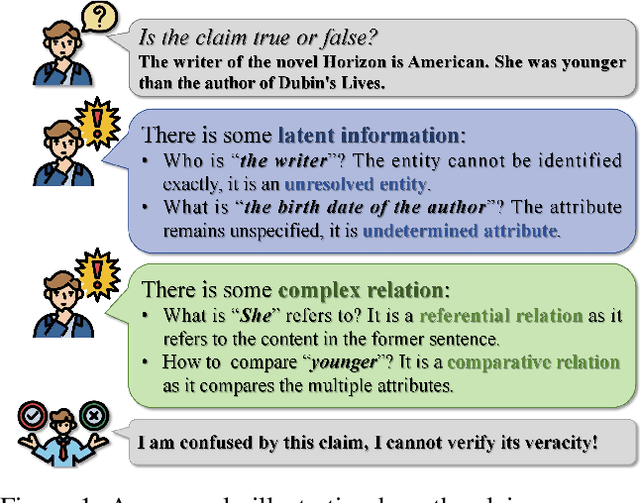

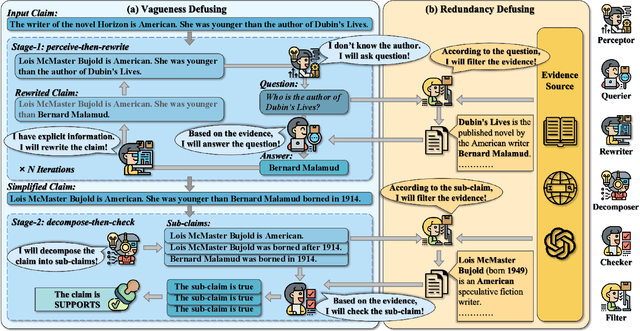
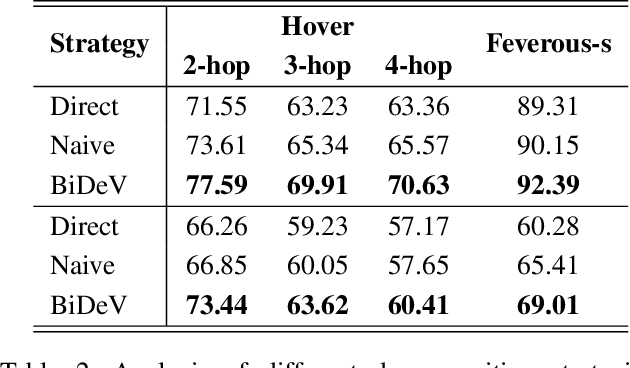
Abstract:Complex claim fact-checking performs a crucial role in disinformation detection. However, existing fact-checking methods struggle with claim vagueness, specifically in effectively handling latent information and complex relations within claims. Moreover, evidence redundancy, where nonessential information complicates the verification process, remains a significant issue. To tackle these limitations, we propose Bilateral Defusing Verification (BiDeV), a novel fact-checking working-flow framework integrating multiple role-played LLMs to mimic the human-expert fact-checking process. BiDeV consists of two main modules: Vagueness Defusing identifies latent information and resolves complex relations to simplify the claim, and Redundancy Defusing eliminates redundant content to enhance the evidence quality. Extensive experimental results on two widely used challenging fact-checking benchmarks (Hover and Feverous-s) demonstrate that our BiDeV can achieve the best performance under both gold and open settings. This highlights the effectiveness of BiDeV in handling complex claims and ensuring precise fact-checking
Phrase Decoupling Cross-Modal Hierarchical Matching and Progressive Position Correction for Visual Grounding
Oct 31, 2024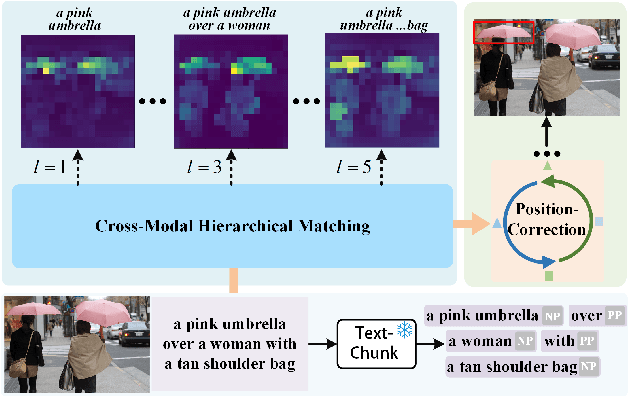


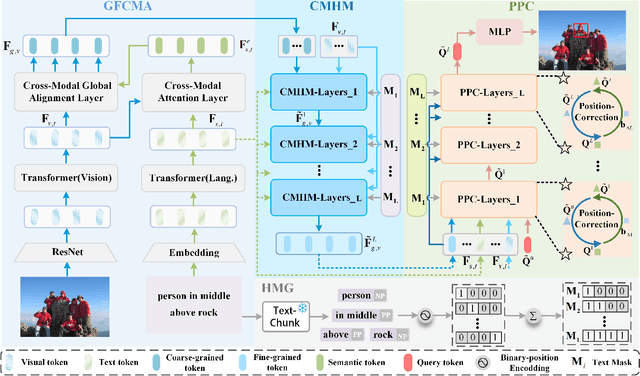
Abstract:Visual grounding has attracted wide attention thanks to its broad application in various visual language tasks. Although visual grounding has made significant research progress, existing methods ignore the promotion effect of the association between text and image features at different hierarchies on cross-modal matching. This paper proposes a Phrase Decoupling Cross-Modal Hierarchical Matching and Progressive Position Correction Visual Grounding method. It first generates a mask through decoupled sentence phrases, and a text and image hierarchical matching mechanism is constructed, highlighting the role of association between different hierarchies in cross-modal matching. In addition, a corresponding target object position progressive correction strategy is defined based on the hierarchical matching mechanism to achieve accurate positioning for the target object described in the text. This method can continuously optimize and adjust the bounding box position of the target object as the certainty of the text description of the target object improves. This design explores the association between features at different hierarchies and highlights the role of features related to the target object and its position in target positioning. The proposed method is validated on different datasets through experiments, and its superiority is verified by the performance comparison with the state-of-the-art methods.
A Mixed-Language Multi-Document News Summarization Dataset and a Graphs-Based Extract-Generate Model
Oct 13, 2024Abstract:Existing research on news summarization primarily focuses on single-language single-document (SLSD), single-language multi-document (SLMD) or cross-language single-document (CLSD). However, in real-world scenarios, news about a international event often involves multiple documents in different languages, i.e., mixed-language multi-document (MLMD). Therefore, summarizing MLMD news is of great significance. However, the lack of datasets for MLMD news summarization has constrained the development of research in this area. To fill this gap, we construct a mixed-language multi-document news summarization dataset (MLMD-news), which contains four different languages and 10,992 source document cluster and target summary pairs. Additionally, we propose a graph-based extract-generate model and benchmark various methods on the MLMD-news dataset and publicly release our dataset and code\footnote[1]{https://github.com/Southnf9/MLMD-news}, aiming to advance research in summarization within MLMD scenarios.
 Add to Chrome
Add to Chrome Add to Firefox
Add to Firefox Add to Edge
Add to Edge